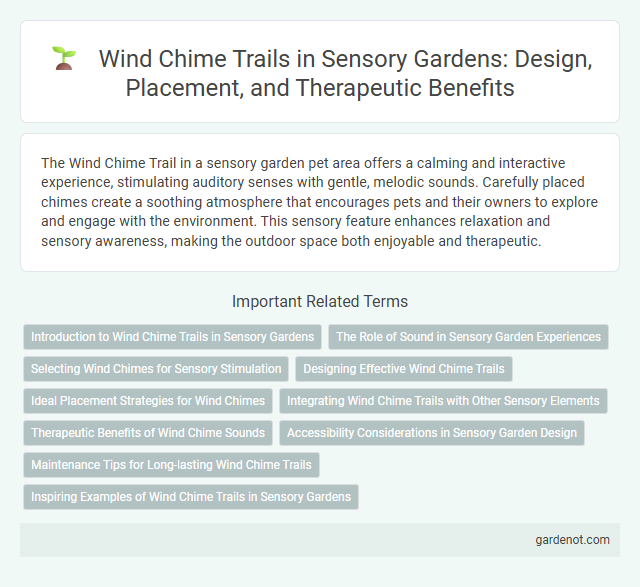The Wind Chime Trail in a sensory garden pet area offers a calming and interactive experience, stimulating auditory senses with gentle, melodic sounds. Carefully placed chimes create a soothing atmosphere that encourages pets and their owners to explore and engage with the environment. This sensory feature enhances relaxation and sensory awareness, making the outdoor space both enjoyable and therapeutic.
Introduction to Wind Chime Trails in Sensory Gardens
Wind chime trails in sensory gardens create a multi-sensory experience by integrating auditory stimulation with natural surroundings. These trails feature strategically placed wind chimes designed to produce soothing sounds that respond to gentle breezes, enhancing sensory engagement for visitors. This interactive element supports relaxation, mindfulness, and sensory exploration, especially benefiting individuals with sensory processing challenges.
The Role of Sound in Sensory Garden Experiences
Wind chime trails enhance sensory garden experiences by introducing dynamic auditory stimuli that engage visitors' sense of hearing. The gentle, melodic tones produced by varying materials and designs encourage relaxation, improve mood, and foster mindfulness within natural environments. Soundscapes created by wind chimes also aid in sensory integration for individuals with sensory processing disorders, making gardens more inclusive and therapeutic.
Selecting Wind Chimes for Sensory Stimulation
Choosing wind chimes for a sensory garden trail involves prioritizing materials and tones that produce soothing, varied sounds to enhance auditory stimulation. Bamboo, metal, and glass chimes offer distinct timbres that engage different sensory responses and contribute to a calming atmosphere. Placement along the trail should maximize natural breezes to ensure consistent sound interaction without overwhelming visitors.
Designing Effective Wind Chime Trails
Designing effective wind chime trails involves selecting a diverse range of chimes that produce varying tones to create a harmonious auditory experience. Placement should optimize natural wind patterns to ensure consistent sound without overwhelming visitors. Incorporating durable, weather-resistant materials and spacing chimes for accessibility enhances both interaction and sensory engagement in the garden.
Ideal Placement Strategies for Wind Chimes
Ideal placement strategies for wind chimes in a sensory garden prioritize locations with consistent gentle breezes to maximize sound activation without overwhelming other sensory elements. Positioning wind chimes near pathways or seating areas encourages visitor engagement while ensuring the tones blend harmoniously with natural surroundings. Avoid placing them too close to dense foliage to prevent muffled sounds, instead choosing open spaces that allow for clear, soothing acoustic experiences.
Integrating Wind Chime Trails with Other Sensory Elements
Integrating wind chime trails with tactile pathways and aromatic plantings enhances the multisensory experience of a sensory garden. Strategic placement of wind chimes near textured surfaces and fragrant herbs stimulates auditory, tactile, and olfactory senses simultaneously. This multisensory integration promotes deeper engagement and therapeutic benefits for visitors, particularly those with sensory processing challenges.
Therapeutic Benefits of Wind Chime Sounds
Wind chime trails in sensory gardens enhance mental well-being by providing soothing auditory stimuli that reduce stress and anxiety. The gentle, melodic tones of wind chimes promote relaxation, improve mood, and support cognitive function through sensory engagement. These therapeutic sounds help create a tranquil environment conducive to mindfulness and emotional healing.
Accessibility Considerations in Sensory Garden Design
The Wind Chime Trail in sensory garden design prioritizes accessibility by incorporating varied chime heights and clear, wide pathways to accommodate wheelchairs and mobility aids. Materials are chosen for durability and ease of maintenance, ensuring safe interaction for users with visual or hearing impairments. Tactile elements and auditory feedback enhance sensory engagement while fostering an inclusive environment for all visitors.
Maintenance Tips for Long-lasting Wind Chime Trails
Regularly inspect wind chimes for wear and tear, ensuring metal components are rust-free and wooden parts are sealed to prevent moisture damage. Clean chimes with a gentle, damp cloth to remove dirt and debris that can mute sound quality over time. Secure hanging points with sturdy hooks or chains to withstand wind exposure and avoid tangling, preserving the acoustic experience along the sensory garden's wind chime trail.
Inspiring Examples of Wind Chime Trails in Sensory Gardens
Wind chime trails in sensory gardens create immersive auditory experiences through strategically placed chimes that respond to natural breezes. Notable examples include the Desert Botanical Garden in Phoenix, featuring a variety of wind chimes that evoke soothing sounds inspired by native flora. The Huntington Library's sensory garden incorporates customizable wind chime installations that enhance mindfulness and sensory engagement for visitors of all ages.
Wind chime trail Infographic

 gardenot.com
gardenot.com